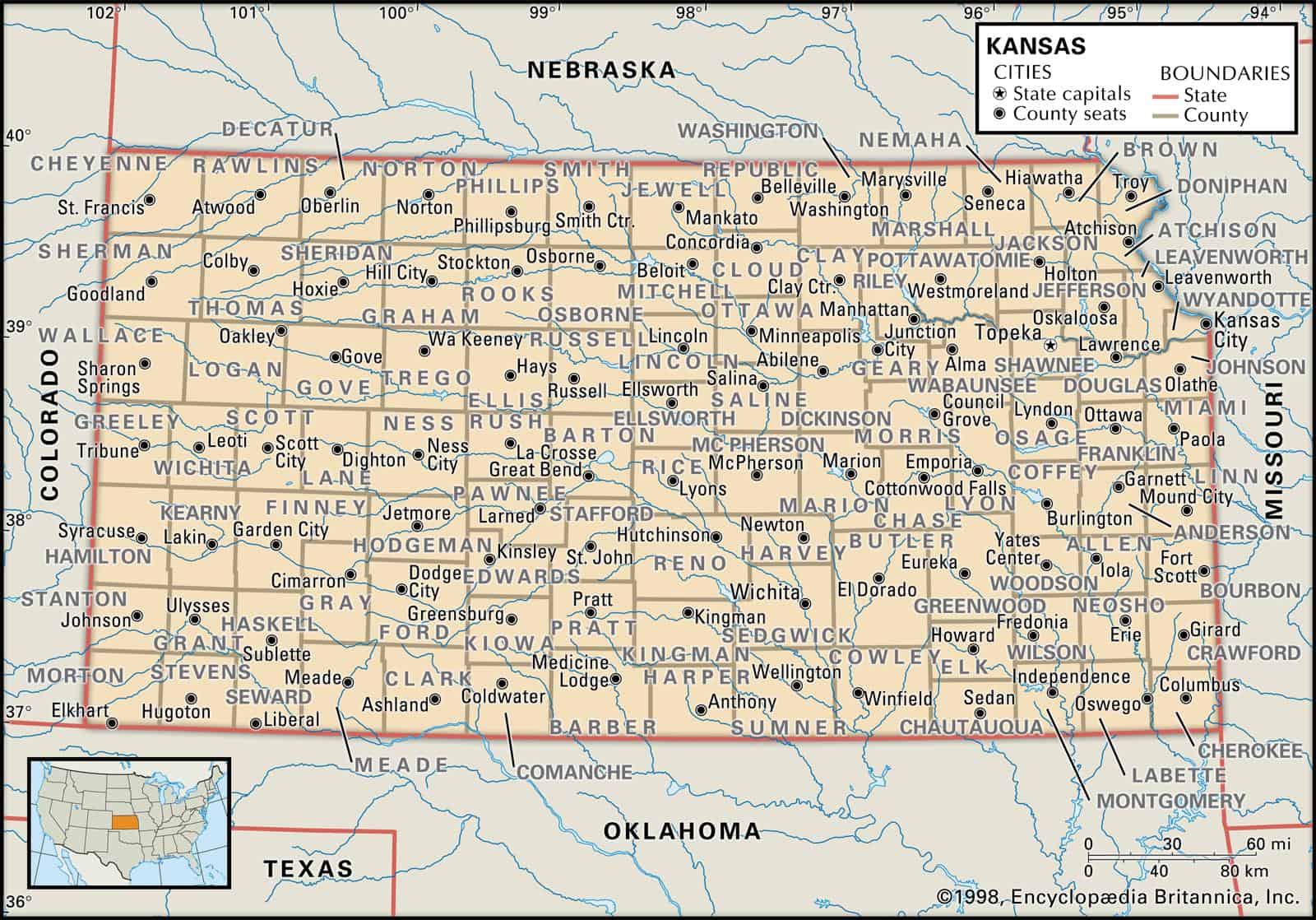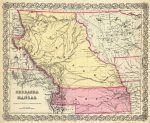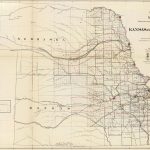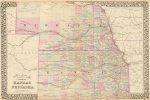
Maps of Kansas are an important tool when it comes to ancestral and family history research, especially in the event that you live far away from where your ancestor lived.
Because the political boundaries of Kansas have frequently changed over the years, historic maps are extremely useful in helping you discover the precise location of your ancestor’s hometown, what land they owned, who their neighbors ended up being, and much more besides.
Maps of Kansas are an outstanding source for getting started with your research since they give reliable information and facts instantly and present them in a clear and easily understandable format.
Kansas’s 10 largest cities are Wichita, Overland Park, Kansas City, Topeka (Capital), Olathe, Lawrence, Shawnee, Manhattan, Lenexa, and Salina.
Learn more historical facts about Kansas counties here.
Interactive Map of Kansas County Formation History
AniMap Plus 3.0, with the permission of the Goldbug Company
List of Every Kansas County
Allen County
Established in 1855, Allen County has a population of around 12,000 and is named after William Allen, a US senator from Ohio.
Anderson County
Anderson County was established in 1855 and has a population of approximately 7,800. It is named after Joseph C. Anderson, a territorial legislator.
Atchison County
Founded in 1855, Atchison County has a population of roughly 16,500 and is named after David Rice Atchison, a US senator from Missouri.
Barber County
Established in 1867, Barber County has a population of around 4,800 and is named after Thomas Barber, a free state settler.
Barton County
Founded in 1867, Barton County has a population of approximately 26,000 and is named after Clara Barton, founder of the American Red Cross.
Bourbon County
Established in 1855, Bourbon County has a population of roughly 14,000 and is named after the House of Bourbon, a European royal family.
Brown County
Brown County was established in 1855 and has a population of around 9,700. It is named after Albert G. Brown, a US senator from Mississippi.
Butler County
Founded in 1855, Butler County has a population of approximately 69,000 and is named after Andrew Butler, a US senator from South Carolina.
Chase County
Established in 1859, Chase County has a population of roughly 2,600 and is named after Salmon P. Chase, a US senator from Ohio and later chief justice of the Supreme Court.
Chautauqua County
Chautauqua County was founded in 1875 and has a population of around 3,200. It is named after the Chautauqua movement, a 19th-century adult education and cultural movement.
Cherokee County
Established in 1866, Cherokee County has a population of approximately 19,000 and is named after the Cherokee Nation.
Cheyenne County
Cheyenne County was founded in 1873 and has a population of around 2,500. It is named after the Cheyenne Native American tribe.
Clark County
Established in 1885, Clark County has a population of roughly 2,200 and is named after Charles F. Clark, a US senator from Wyoming.
Clay County
Founded in 1857, Clay County has a population of approximately 8,000 and is named after Henry Clay, a US senator from Kentucky and Speaker of the House.
Cloud County
Established in 1867, Cloud County has a population of around 8,700 and is named after William F. Cloud, a US senator from Kansas.
Coffey County
Founded in 1855, Coffey County has a population of approximately 8,100 and is named after James A. Coffey, a territorial legislator.
Comanche County
Established in 1873, Comanche County has a population of roughly 1,800 and is named after the Comanche Native American tribe.
Cowley County
Founded in 1867, Cowley County has a population of approximately 34,000 and is named after Matthew Cowley, a US senator from Kentucky.
Crawford County
Established in 1867, Crawford County has a population of around 38,000 and is named after Samuel J. Crawford, governor of Kansas during the Civil War.
Dickinson County
Established in 1857, Dickinson County has a population of approximately 19,000 and is named after Daniel S. Dickinson, a US senator from New York.
Doniphan County
Founded in 1855, Doniphan County has a population of around 7,700 and is named after Alexander W. Doniphan, a Missouri lawyer and military leader.
Douglas County
Established in 1855, Douglas County has a population of roughly 121,000 and is named after Stephen A. Douglas, a US senator from Illinois and presidential candidate.
Edwards County
Founded in 1874, Edwards County has a population of approximately 2,800 and is named after John H. Edwards, a US senator from Missouri.
Elk County
Established in 1875, Elk County has a population of around 2,500 and is named after the elk that used to inhabit the area.
Ellis County
Founded in 1867, Ellis County has a population of approximately 29,000 and is named after George Ellis, lieutenant governor of Kansas from 1865 to 1868.
Ellsworth County
Established in 1867, Ellsworth County has a population of roughly 6,300 and is named after Fort Ellsworth, a US Army post that was located in the area.
Finney County
Founded in 1883, Finney County has a population of approximately 37,000 and is named after David W. Finney, lieutenant governor of Kansas from 1877 to 1879.
Ford County
Established in 1873, Ford County has a population of around 34,000 and is named after James H. Ford, a US senator from Indiana.
Franklin County
Founded in 1855, Franklin County has a population of approximately 26,000 and is named after Benjamin Franklin, one of the founding fathers of the United States.
Geary County
Established in 1855, Geary County has a population of around 35,000 and is named after John W. Geary, a former governor of Kansas Territory.
Gove County
Founded in 1886, Gove County has a population of approximately 2,600 and is named after Grenville M. Dodge, a Union Army general and civil engineer who played a key role in the construction of the transcontinental railroad.
Graham County
Established in 1880, Graham County has a population of around 2,500 and is named after Captain John L. Graham, a soldier who was killed in the Battle of Chickamauga during the American Civil War.
Grant County
Founded in 1887, Grant County has a population of approximately 7,000 and is named after Ulysses S. Grant, the 18th president of the United States.
Gray County
Established in 1881, Gray County has a population of around 6,000 and is named after Alfred Gray, a Kansas senator and a judge of the state Supreme Court.
Greeley County
Founded in 1886, Greeley County has a population of approximately 1,300 and is named after Horace Greeley, a newspaper editor and political activist who ran for president in 1872.
Greenwood County
Established in 1855, Greenwood County has a population of around 6,000 and is named after Alfred B. Greenwood, a US senator from Arkansas.
Hamilton County
Founded in 1867, Hamilton County has a population of approximately 2,000 and is named after Alexander Hamilton, one of the founding fathers of the United States.
Harper County
Established in 1873, Harper County has a population of around 5,000 and is named after Marion Harper, a Kansas senator and a judge of the state Supreme Court.
Harvey County
Founded in 1872, Harvey County has a population of approximately 35,000 and is named after James M. Harvey, a Kansas governor during the Civil War.
Haskell County
Established in 1887, Haskell County has a population of around 4,000 and is named after Dudley C. Haskell, a Kansas congressman.
Hodgeman County
Founded in 1867, Hodgeman County has a population of approximately 1,800 and is named after Amos Hodgman, a Union Army colonel who died in the Battle of Jenkins Ferry during the American Civil War.
Jackson County
Established in 1855, Jackson County has a population of around 13,000 and is named after Andrew Jackson, the seventh president of the United States.
Jefferson County
Founded in 1855, Jefferson County has a population of approximately 19,000 and is named after Thomas Jefferson, the third president of the United States.
Jewell County
Established in 1870, Jewell County has a population of around 3,000 and is named after Lewis R. Jewell, a Kansas senator.
Johnson County
Founded in 1855, Johnson County has a population of approximately 620,000 and is the most populous county in Kansas. It is named after Thomas Johnson, a US senator from Maryland.
Kearny County
Established in 1887, Kearny County has a population of around 4,000 and is named after General Stephen Watts Kearny, a US Army officer who played a prominent role in the Mexican-American War.
Kingman County
Founded in 1872, Kingman County has a population of approximately 7,500 and is named after Samuel A. Kingman, a Kansas senator.
Kiowa County
Established in 1886, Kiowa County has a population of around 2,500 and is named after the Kiowa Native American tribe.
Labette County
Founded in 1867, Labette County has a population of approximately 20,000 and is named after Labette Creek, which flows through the area.
Lane County
Established in 1886, Lane County has a population of around 1,500 and is named after James H. Lane, a US senator from Kansas who was also involved in the abolitionist movement.
Leavenworth County
Founded in 1855, Leavenworth County has a population of approximately 82,000 and is named after Fort Leavenworth, a US Army post located within the county.
Lincoln County
Established in 1867, Lincoln County has a population of around 2,800 and is named after Abraham Lincoln, the 16th president of the United States.
Linn County
Founded in 1867, Linn County has a population of approximately 9,000 and is named after Lewis F. Linn, a US senator from Missouri who supported the admission of Kansas as a state.
Logan County
Established in 1887, Logan County has a population of around 2,800 and is named after John A. Logan, a Union Army general during the American Civil War who later became a US senator from Illinois.
Lyon County
Founded in 1855, Lyon County has a population of approximately 33,000 and is named after General Nathaniel Lyon, a Union Army general who was killed in the Battle of Wilson’s Creek during the American Civil War.
McPherson County
Established in 1867, McPherson County has a population of around 29,000 and is named after James B. McPherson, a Union Army general who was killed in the Battle of Atlanta during the American Civil War.
Marion County
Founded in 1865, Marion County has a population of approximately 12,000 and is named after Francis Marion, a Revolutionary War general who was also known as the “Swamp Fox”.
Marshall County
Established in 1855, Marshall County has a population of around 9,500 and is named after John Marshall, the fourth chief justice of the United States.
Meade County
Founded in 1873, Meade County has a population of approximately 4,000 and is named after General George Meade, a Union Army general who commanded the Army of the Potomac during the Battle of Gettysburg.
Miami County
Established in 1855, Miami County has a population of around 33,000 and is named after the Miami Native American tribe.
Mitchell County
Founded in 1867, Mitchell County has a population of approximately 6,000 and is named after William Mitchell, a Kansas senator.
Montgomery County
Established in 1869, Montgomery County has a population of around 31,000 and is named after Richard Montgomery, an American Revolutionary War general who was killed in the Battle of Quebec.
Morris County
Founded in 1855, Morris County has a population of approximately 5,000 and is named after Thomas Morris, a Kansas senator.
Morton County
Established in 1887, Morton County has a population of around 3,000 and is named after Oliver Morton, the governor of Indiana during the American Civil War.
Nemaha County
Founded in 1855, Nemaha County has a population of approximately 10,000 and is named after the Nemaha River, which runs through the area.
Neosho County
Established in 1864, Neosho County has a population of around 16,000 and is named after the Neosho River, which flows through the area.
Ness County
Founded in 1867, Ness County has a population of approximately 3,000 and is named after Noah V. Ness, a Kansas legislator.
Norton County
Established in 1872, Norton County has a population of around 5,500 and is named after Orloff Norton, a Union Army general during the American Civil War.
Osage County
Founded in 1855, Osage County has a population of approximately 16,000 and is named after the Osage Native American tribe.
Osborne County
Established in 1867, Osborne County has a population of around 3,500 and is named after Vincent B. Osborne, a Kansas legislator.
Ottawa County
Founded in 1866, Ottawa County has a population of approximately 6,000 and is named after the Ottawa Native American tribe.
Pawnee County
Established in 1867, Pawnee County has a population of around 6,500 and is named after the Pawnee Native American tribe.
Phillips County
Founded in 1867, Phillips County has a population of approximately 5,000 and is named after William A. Phillips, a Kansas senator.
Pottawatomie County
Established in 1855, Pottawatomie County has a population of around 24,000 and is named after the Pottawatomie Native American tribe.
Pratt County
Founded in 1867, Pratt County has a population of approximately 10,000 and is named after Caleb S. Pratt, a Kansas senator.
Rawlins County
Established in 1873, Rawlins County has a population of around 2,500 and is named after John Aaron Rawlins, a Union Army general during the American Civil War who also served as Secretary of War under President Ulysses S. Grant.
Reno County
Founded in 1867, Reno County has a population of approximately 62,000 and is named after Jesse L. Reno, a Union Army general who was killed in the Battle of South Mountain during the American Civil War.
Republic County
Established in 1860, Republic County has a population of around 4,500 and is named after the Republican River, which runs through the area.
Rice County
Founded in 1867, Rice County has a population of approximately 9,500 and is named after Samuel A. Rice, a Kansas senator.
Riley County
Established in 1855, Riley County has a population of around 76,000 and is named after Bennett Riley, a Union Army general and governor of California.
Rooks County
Founded in 1872, Rooks County has a population of approximately 5,000 and is named after John C. Rooks, a Kansas legislator.
Rush County
Established in 1867, Rush County has a population of around 3,000 and is named after Alexander Rush, a Kansas legislator.
Russell County
Founded in 1867, Russell County has a population of approximately 7,000 and is named after Avra P. Russell, a Kansas senator.
Saline County
Established in 1860, Saline County has a population of around 54,000 and is named after the Saline River, which flows through the area.
Scott County
Founded in 1873, Scott County has a population of approximately 5,000 and is named after Winfield Scott, a Union Army general during the Mexican-American War and the American Civil War.
Sedgwick County
Established in 1867, Sedgwick County has a population of around 520,000 and is named after John Sedgwick, a Union Army general who was killed in the Battle of Spotsylvania Court House during the American Civil War.
Seward County
Founded in 1883, Seward County has a population of approximately 23,000 and is named after William H. Seward, the United States Secretary of State under President Abraham Lincoln.
Shawnee County
Established in 1855, Shawnee County has a population of around 178,000 and is named after the Shawnee Native American tribe.
Sheridan County
Founded in 1880, Sheridan County has a population of approximately 2,500 and is named after Philip H. Sheridan, a Union Army general during the American Civil War.
Sherman County
Established in 1886, Sherman County has a population of around 5,500 and is named after William Tecumseh Sherman, a Union Army general who led the March to the Sea during the American Civil War.
Smith County
Founded in 1867, Smith County has a population of approximately 3,700 and is named after Major J. Nelson Smith, a Kansas legislator and army officer.
Stafford County
Established in 1870, Stafford County has a population of around 4,200 and is named after Lewis Stafford, a Kansas legislator.
Stanton County
Founded in 1887, Stanton County has a population of approximately 2,000 and is named after Edwin M. Stanton, the United States Secretary of War under President Abraham Lincoln.
Stevens County
Established in 1886, Stevens County has a population of around 5,500 and is named after Thaddeus Stevens, a United States representative and leader of the Radical Republican faction of the Republican Party during the American Civil War.
Sumner County
Founded in 1870, Sumner County has a population of approximately 22,000 and is named after Charles Sumner, a United States senator from Massachusetts who was a leading abolitionist and advocate for civil rights.
Thomas County
Established in 1885, Thomas County has a population of around 8,000 and is named after George H. Thomas, a Union Army general during the American Civil War.
Trego County
Founded in 1879, Trego County has a population of approximately 2,900 and is named after Edgar P. Trego, a Kansas legislator and army officer.
Wabaunsee County
Established in 1859, Wabaunsee County has a population of around 6,900 and is named after the Wabaunsee Native American tribe.
Wallace County
Founded in 1868, Wallace County has a population of approximately 1,500 and is named after W.H.L. Wallace, a Union Army general who was killed in the Battle of Shiloh during the American Civil War.
Washington County
Established in 1857, Washington County has a population of around 5,500 and is named after George Washington, the first President of the United States.
Wichita County
Founded in 1886, Wichita County has a population of approximately 2,200 and is named after the Wichita Native American tribe.
Wilson County
Established in 1869, Wilson County has a population of around 8,500 and is named after Colonel Hiero T. Wilson, a Kansas legislator and army officer.
Woodson County
Founded in 1855, Woodson County has a population of approximately 3,000 and is named after Daniel Woodson, the secretary of the Kansas Territory and a supporter of slavery.
Wyandotte County
Established in 1859, Wyandotte County has a population of around 165,000 and is named after the Wyandot Native American tribe.
Old Antique Atlases & Maps of Kansas
Disclaimer: All Kansas maps are free to use for your own genealogical purposes and may not be reproduced for resale or distribution.
Source: David Rumsey Historical Map Collection
-

1856 Nebraska And Kansas Atlas Map
-

1866 Map of Kansas and Nebraska
1866 Map Showing the progress of the Public surveys in Kansas and Nebraska
-

1880 Map Of Kansas and Nebraska
1880 County & township map of the states of Kansas and Nebraska
D.O.T. County Road and Highway Maps of Kansas
To View the Map: Just click the image to view the map online. In order to make the image size as small as possible, they were saved on the lowest resolution.
Kansas Map Links
- Kansas State Park Map (mapofus.org)
- Kansas Lakes and Rivers Map (mapofus.org)
- Kansas Map With Cities and Highways (mapofus.org)
- Historical Maps of Kansas (alabamamaps.ua.edu)
- Kansas Digital Map Library (usgwarchives.net)
- Kansas Maps, Atlases & Gazetteers (ancestry.com)
- Kansas Maps – The Perry-Castañeda Library Map Collection (lib.utexas.edu)
- U.S., Indexed County Land Ownership Maps, 1860-1918 (ancestry.com)
- American Memory Map Collection: 1500-2004 (memory.loc.gov)
- Kansas USGenWeb Archives Digital Map Library (usgwarchives.net)
- Old Kansas Area Maps (kancoll.org)
- KDOT Historic State Maps (ksdot.org) NOTE all PDF files will require Adobe Reader to use
- County Subdivision Outline Map and County Location Index (census.gov)
- Kansas Map Books (amazon.com)

